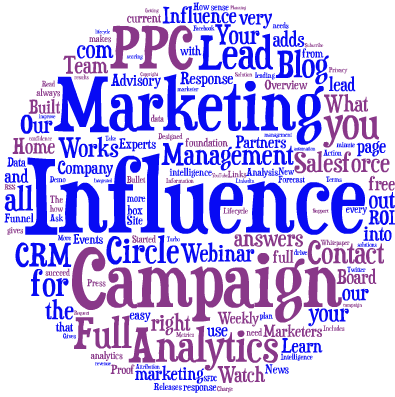What is Marketing Campaign Influence, and How Can B2B Marketers Use It?
An interview with Andrea Wildt, VP of Product and Marketing for Full Circle CRM.
As marketing budgets continue to expand, it’s increasingly critical to understand how marketing efforts impact pipeline. Traditional ROI models give credit to a single effort that impacted a sale or opportunity. For example, if a prospect views a tweet, then performs a Google search, and then finally clicks through to your website and downloads a whitepaper before making a purchase, the whitepaper will likely get full credit for the lead.
 This is problematic in B2B sales cycles, which tend to be longer and more complex. For example, a prospect might find your blog post on Twitter, visit your site, download a whitepaper, sign up for a free trial, open several emails, and talk to a sales agent before becoming a customer.
This is problematic in B2B sales cycles, which tend to be longer and more complex. For example, a prospect might find your blog post on Twitter, visit your site, download a whitepaper, sign up for a free trial, open several emails, and talk to a sales agent before becoming a customer.
The most innovative marketers are using something called campaign influence, or sales influence, to measure what works and what doesn’t. Measuring influence helps marketers make better decisions about not only which efforts help close deals, but also when in the sales cycle those efforts are most effective.
While Salesforce.com’s native influence report enables marketers to start gaining insight into campaign influence, other solutions allow even more granular influence reporting. Andrea Wildt sat down with us to explain how to get started.
Revenue.io: What sorts of businesses can benefit most from measuring campaign influence?
Andrea Wildt: In general, it tends to be more useful for B2B companies than B2C. B2B companies tend to have more complex sales and can be touched by many more marketing campaigns and sales reps. Since the introduction of marketing automation solutions, marketers are becoming more sophisticated in how we budget, plan, generate demand and nurture our prospects as well as opportunities. It has become increasingly important to benchmark every communication or program that touches our prospects throughout the entire sales cycle.
Revenue.io: What’s the most basic way to get started with campaign influence?
Andrea Wildt: If you’re a Salesforce customer, the best way to get started is with the standard Salesforce influence report. This is a good first step because it helps acclimate marketers to the fact that there are multiple touches and gives some general visibility into what those touches are.
Revenue.io: Does the standard influence attribution model have any shortcomings?
Andrea Wildt: One thing to be aware of is that the native Salesforce report attributes 100% of every opportunity value to every touch point. Say I close a $1 million deal. The native report would tell me that all of the touches involved are responsible for $1 million, which just isn’t the case. However, it can still be a good first step for marketers who want to get their feet wet with campaign influence.
Revenue.io: What is another way of measuring influence?
Andrea Wildt: At Full Circle CRM, we use a weighted influence model which distributes that opportunity value among all the various campaign touches.
 Revenue.io: What are some advantages to a weighted model?
Revenue.io: What are some advantages to a weighted model?
Andrea Wildt: Going to a weighted model just gives you so much more flexibility. The value of each touch can be distributed in any way that makes sense to a business. Every company is unique, and so value can be applied based on what’s most important to a business. For example, we have some clients that give more weighting to campaigns that are tied to a decision maker and less weighting for campaigns tied to the technical evaluator. A weighted model allows companies to be more strategic with how they distribute opportunity value to the campaigns. Then, when they run an ROI report based on influence, the reporting always adds up to 100%. So it’s really easy for management to understand and consume the data.
Revenue.io: What are some of the benefits that your clients have experienced from measuring influence?
Andrea Wildt: Our clients use our influence models to see what programs are contributing to pipeline and closed revenue. That way they can reinvest in the programs that have a lot of influence and drop the programs that simply aren’t working for them. Additionally it helps them see where in the sales cycle those programs are touching individuals. And that’s really exciting because sophisticated marketers can then go back and start to tailor their nurturing and marketing activities based on where someone is in the sales cycle.
Revenue.io: Realistically, how many hours is someone going to put into configuration to get started with basic campaign influence measurement?
Andrea Wildt: We have a couple of pre-built influence models that some of our customers use, but it can take up to two weeks for planning and writing custom code. Once the influence models are established, implementation itself is really quick since it’s a native Salesforce application. We install it, configure it, turn it on and run the database. It only takes a day to get it up and running after the influence models have been established.
Revenue.io: What are some challenges that marketers face when measuring influence?
Andrea Wildt: The hardest part is getting mind share about how influence should be attributed. It’s important that marketers, management and the sales organization agree about how to measure influence. If everyone is on the same page it can avoid awkward conversations such as managers saying that they don’t trust the numbers.
Revenue.io: Since your customers are measuring influence in different ways do you often start with a consultation?
Andrea Wildt: We have a lot of experience in the Salesforce ecosystem and are familiar with many of the challenges that businesses face. We try to work with businesses to help them develop the best influence model. During our initial consultation we ask businesses questions like how does your business work? How does the sales organization work? And try to find out if it makes more sense to measure influence tied to an account rather than just an opportunity.
Revenue.io: Are you using your own product to measure influence?
Andrea Wildt: Absolutely. We’re running three influence models right now.
Revenue.io: How do you like to distribute influence?
Andrea Wildt: Lately, I’ve been giving higher weight to tipping point campaigns and then assigning equal distribution to everything else.
Revenue.io: What’s an example of a way that measuring influence has helped your business?
Andrea Wildt: Internally, one of our sales reps was convinced that leads from a certain whitepaper weren’t good. So we went in and ran the numbers and saw that, sure enough, that campaign was not good at generating opportunities. But what we did find is that that campaign has influenced a lot of opportunities prior to close. Since it’s a thought leadership piece it helped to give us credibility . Without measuring influence, we would have abandoned that whitepaper. Instead, we realized that it really does touch a lot of our deals.
To learn more about Andrea and campaign influence, please check out Full Circle CRM.